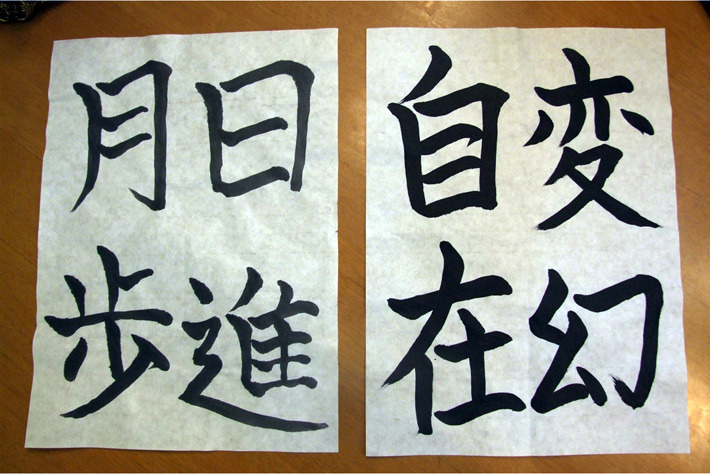For the longest time I’ve run across all kinds of Japanese idioms that follow the same sort of pattern, not even realizing that they were an actual “thing.” They’d be like this:
- Four kanji.
- Meanings of the individual kanji don’t really have much to do with the idiom on a whole.
- Probably comes from some story – in fact, if you don’t know the story it’s hard or impossible to derive their meaning.
While there are other types of idioms in Japanese, idioms like that follow the above pattern are known as yojijukugo ( 四字熟語), aka “four-character compounds” or “four-character idioms.” What’s interesting to me here are the constraints. You only have four characters to convey what it is you want to say. In fact, these four characters are usually meant to represent an entire story (presumably filled with morals and lessons and other educational things like that). I’ve always thought that constraints like these breed creativity (kind of like the constraints of boxy kei-cars), and I wouldn’t say yojijukugo disappoints.
The thing is, we do this in English too (though the constraints are much looser). Ever heard the idiom “A wolf in sheep’s clothing”? It comes from multiple stories and fables. It doesn’t literally mean a wolf is wearing sheep’s clothing. That would be a smart wolf. No, it’s an idiom representing a story you’re already supposed to know, which then gives you the context and allows you to understand the meaning of the idiom on a whole.
Yojijukugo’s Chinese Origins

Like many things (especially kanji things), the yojijukugo have Chinese roots and origins. The Japanese yojijukugo can be traced back to the Chinese Chengyu, which are essentially the same thing but Chinese. In fact, many of the Yojijukugo idioms just copypasta straight from the Chinese version. There are some slight modifications in the readings to make them more Japanese.
Also like the Chengyu, the yojijukugo characters (the kanji, not characters in a story) often represent individual ideas and morals that are in the story that they come from. This is why it’s often so hard to derive meaning straight from the idiom without knowing the story first; they are kind of like mnemonics that help you to remember the story (and therefor help you to remember a lesson as well). Ancient mnemonics, anyone?
Now the Japanese yojijukugo idioms aren’t all copycats. While many (probably most) of them do come from a Chinese original, there are many Japanese-only yojijukugo as well. These would be things that come from Buddhist scripture, Japanese proverbs, and old Japanese stories. Just like the chengyu, though, you still need the stories to understand the yojijukugo’s meaning.
Some Common Japanese Idioms

The thing is, there are a ton of these. I’ve found counts ranging from 5,000 to over 20,000. That’s obviously way too many to learn. Here is a database of 3,400 of them (still too many), though if you scroll through you’ll see that the most useful ones are marked with a ##. Still, this only narrows the list down to around 400 “useful” yojijukugo, and that’s too much all in one sitting.
Instead, I found a list of presumably some of the most common and liked ones. This way if you have an itch to learn them you can start with the ones that will get you the most mileage first, then only after that learn the other 19,980 (I’m sure there’s an idiom for how you’d feel if you had to learn all of these… maybe shimensoka 四面楚歌?).
- 一期一会
- “Once In A Lifetime Opportunity”
- 一石二鳥
- “Killing two birds with one stone”
- 初志貫徹
- “Achieving one’s original intention”
- 以心伝心
- “Without any need for words”
- 一所懸命
- “With utmost effort”
- 温故知新
- “Learning from the past”
- 花鳥風月
- “The beauties of nature”
- 臥薪嘗胆
- “Going through thick and thin to attain one’s objective”
- 質実剛健
- “Unaffected and sincere”
- 十人十色
- “To each his own”
- 晴耕雨読
- “Living in quiet retirement dividing time between work and intellectual pursuits”
- 清浄潔白
- “Pure in heart and with a clean conscious”
- 切磋琢磨
- “Cultivate one’s mind by studying hard”
- 天真爛漫
- “Simple and innocent”
- 日進月歩
- “Steady progress”
- 不言実行
- “Actions before words”
- 粉骨砕身
- “Work oneself to the bone”
- 悠々自適
- “Living a life of leisure with dignity”
- 臨機応変
- “Playing it by ear”
For some of these you can see where the word came from. For example, 十人十色 literally means “ten people ten colors.” You can see where “to each his own” comes from when you look at that. Others are a lot less obvious and require you to know the story behind it, just because the meanings of the kanji are just jibberish without context.
Of course, there are a ton more idioms like the ones listed above. You’re only seeing the tip of the iceberg (or should I say 冰山一角?). There are thousands and thousands more idioms out there, but I wouldn’t say they’re worth learning. You have to set your priorities if you want to move quickly… some things are more important than others. While learning some of the most common yojijukugo is going to be very helpful to you, attempting to learn all of them is something that should be done post-fluency. It’s just not something that’s worth your time otherwise, though I could see how learning them might be fun.
All that being said, what do you think I missed? What yojijukugo do you love? I’m pretty partial to 気剣体一 (spirit, sword, body: one) because it gets yelled at us all the time during kendo, but what about you?
